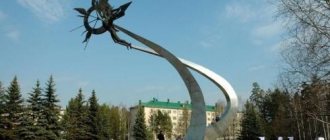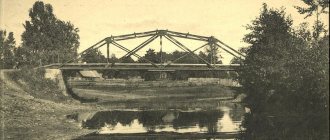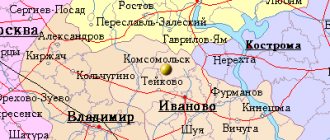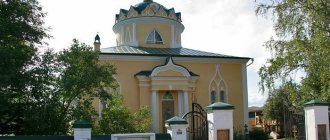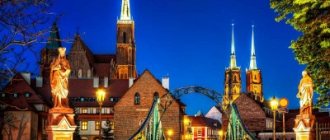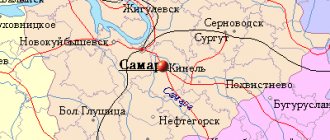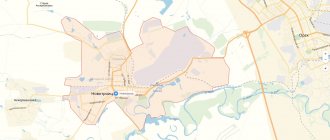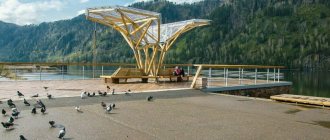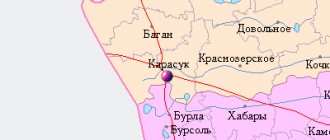City in Moscow region, Russia
| Pushchino Pushchino | |
| Town[1] | |
| Pushchino from the air | |
| Flag Coat of arms | |
| Location of Pushchino | |
| Pushchino Location of Pushchino Show map of Russia Pushchino Pushchino (Moscow region) Show map of the Moscow region | |
| Coordinates: 54°50′N 37°37'E / 54.833°N Latitude 37.617°E / 54.833; 37.617Coordinates: 54°50′N 37°37'E / 54.833°N Latitude 37.617°E / 54.833; 37.617 | |
| A country | Russia |
| Federal subject | Moscow region[1] |
| Known since | 16th century |
| City status from | 1966 |
| Height | 190 m (620 ft) |
| population (2010 Census)[2] | |
| • General | 20,332 |
| • Evaluate (2018)[3] | 20,962 (+3.1%) |
| Administrative status | |
| • Subordinate | Pushchino City of regional subordination[1] |
| • Capital from | Pushchino regional subordination[1] |
| Municipal status | |
| • Urban district | Pushchino urban district[4] |
| • Capital from | Pushchino urban district[4] |
| Timezone | UTC + 3 (MSK [5]) |
| Postal code(s)[6] | 142290 |
| OKTMO I WOULD | 46762000001 |
| Web site | www.pushchino.RU |
Pushchino
(Russian: Pushchino, IPA: [ˈPuɕːɪnə]) is a town in the Moscow region, Russia, an important scientific center of the Russian Academy of Sciences.
Located 100 kilometers (62 miles) south of Moscow, and 13 km southeast of Serpukhov, on the right bank of the river. The Oka River opposite the Prioksko-Terrasny Nature Reserve. Unofficially, it is called Pushchino-on-Oka.[ citation needed
] Population: 20,332 (2010 Census);[2]19,964 (2002 Census);[7]19,479 (1989 Census).[8]
The Pushchino Scientific Center of the Russian Academy of Sciences has a unique status and significance. It houses the main component of the Russian Federation's efforts in the fields of physical, chemical and biomolecular biology. It employs more than 3,000 people, of whom 800 have a doctorate. science or medicine. Pushchino scientists have made seminal contributions to molecular and cellular biology, bioorganic chemistry, plant and soil biology, as well as astronomy and astrophysics—including the discovery of the solar supercorona and the radial magnetic fields within it, and the discovery of radio wave recombination lines of highly excited atoms.[9]
Notes
- ↑. Mosoblaststat. Access date: April 20, 2022.
- according to the resolution of the Council of Ministers of the USSR No. 1855r dated July 7
- (unavailable link). CNews.
- from the point of view of the administrative-territorial structure
- from the point of view of the municipal structure
- . pushino.bezformata.com. Access date: October 22, 2022.
- .
- A. B. Chizhkov
. Estates near Moscow. Scientific Ed. Ph.D. M. A. Polyakova. Res. Kan.archit. E. N. Chernyavskaya. - M. 2006. Ed. 3rd add. Pushchino. p. 186. ISBN 5-8125-0763-5. - ↑
- . Demoscope Weekly. Access date: September 25, 2013.
- .
- .
- . Access date: January 2, 2014.
- . Federal State Statistics Service. Access date: November 24, 2013.
- . Access date: May 31, 2014.
- . Access date: November 16, 2013.
- . Date accessed: August 2, 2014.
- . Date accessed: August 6, 2015.
- (October 5, 2018). Access date: May 15, 2022.
- (July 31, 2017). Access date: July 31, 2022.
- . Access date: July 25, 2022.
- . Access date: July 31, 2022.
- taking into account the cities of Crimea
- (RAR archive (1.0 MB)). Federal State Statistics Service
. - (unavailable link). Access date: October 11, 2012.
Attractions
Kizel (city district)
Pushchino-on-Oka estate in 2008
- On the northwestern outskirts of the city on the banks of the Oka, the remains of the noble estate Pushchino-on-Oka, which was owned by the nobles of Pushchina (1578-1699), the Artsybashevs (1699-1806), and the Ofrosimovs (1806-1852), have been preserved. Both the estate and the park are very neglected. In 1977, the film “Unfinished Piece for Mechanical Piano” was filmed at the estate.
- 4 km south of the city there is the Bolshoye Gryzlovo (Pushchino) airfield, where you can fly airplanes, hang gliders and helicopters, as well as parachute jump.
- At the end of April - beginning of May, you can visit the annual All-Union (now All-Russian) festival of bard songs, which has been taking place in the House of Scientists in Pushchino since 1983.
- Michael the Archangel Church.
- Giant antennas of the DKR-1000 radio telescope, which is a cross of two parabolic cylinders measuring 2*1000*40 m.
- Since 2011, the world's longest running sports tournament, “What? Where? When?" — “Oka Marathon 36 hours non-stop.”
Famous people associated with Pushchino
- Academician Frank, Gleb Mikhailovich - founder of the scientific center
- Academician Ierusalimsky, Nikolai Dmitrievich
- Academician Scriabin, Georgy Konstantinovich
- Academician Spirin, Alexander Sergeevich
- Nikitina, Tatyana Khashimovna and Nikitin, Sergey Yakovlevich - performers of bard songs
- Markovich, Dan Semenovich - artist and writer
- Konovalenko, Dmitry Nikolaevich - expert on the “What? Where? When?”, journalist
- Kryukov, Dmitry Vitalievich - author of the search engine "Rambler"
- Professor Beloyartsev, Felix Fedorovich
- Professor Shnol, Simon Elyevich
- Professor Vitkevich, Viktor Vitoldovich
- builder Nasibullin, Abdula Garipovich - Honored Builder of the City of Pushchino
Berezovsky urban district
Pushchino
| Year of foundation: | 1956 |
| Population: | 21 thousand people |
| Residents: | Pushchintsy |
| Timezone: | UTC+3 |
| Time: | Moscow |
| Telephone code: | +7 4967 |
| Postcode: | 142290 |
| From Moscow: | 80 km |
Urban district Bogotol city
Pushchino is a city in the Moscow region, a science city of the Russian Federation on the right bank of the Oka River, approximately 26 km from Serpukhov. The city of Pushchino is known as the Pushchino Biological Research Center - there are 9 research institutes and 1 RAS observatory in the city. Since 1962 it has had the status of “Scientific Center for Biological Research”, since 2005 it has had the status of “Science City”.
1 km west of the modern city, in the 12th-16th centuries, the city of Teshilov was located, the earthen ramparts of which can still be seen today. The modern city itself received its name from the village of Pushchino, which is located on its northwestern outskirts and was first mentioned in the scribe books of the times of Ivan the Terrible as the estate of the Pushchin family. In the XVIII-XIX centuries. On the banks of the Oka, the noble estate Pushchino-on-Oka arose (now in an ownerless, disrepair condition). In 1956 (April 13), the USSR Council of Ministers issued Resolution No. 501 “On the construction of a scientific campus of the USSR Academy of Sciences.” A place was chosen for construction on the high bank of the Oka River in the Serpukhov district of the Moscow region.
First, workers' barracks and the Sputnik store were built, and in 1959, construction began on the first multi-entrance city house (the historical center of the city is a gray brick house). In 1961, the first stone was laid in the foundation of the building of the Institute of Biophysics of the USSR Academy of Sciences, from which the Pushchino Scientific Center for Biological Research grew from 1962. In 1966 (according to the decree of the Presidium of the Supreme Soviet of the RSFSR No. 929 of August 23 “On the transformation of the workers' village of Pushchino into a city of regional subordination”), the academic town of Pushchino was transformed into a city of regional subordination, and in 1975 Pushchino became a city of regional subordination. In October 2005, the city received the status of a science city of Russia.
On the northwestern outskirts of the city on the banks of the Oka, the remains of the noble estate Pushchino-on-Oka, which was owned by the nobles of Pushchina (1578-1699), the Artsybashevs (1699-1806), and the Ofrosimovs (1806-1852), have been preserved. Both the estate and the park are very neglected.
4 km south of the city there is the Bolshoye Gryzlovo (Pushchino) airfield, where you can fly airplanes, hang gliders and helicopters and parachute jump.
And on the other side of Serpukhov there is the abandoned estate of Pushchino-on-Nara.
Forest, reserves and protected areas
The Oka River draws an approximate boundary between coniferous and deciduous forests. North of the Oka in Pushchino a mixed forest begins, including spruce and birch, which extends into northern Russia. Pushchino itself and to the south are deciduous forests with a predominance of oak, linden, elm, ash, aspen, and without admixture spruce, before giving way to arable land. Near the river, willow trees grow in dense thickets.
The city of Pushchino has an active environmental program called Ecopolis, which has identified several areas where conservation measures are currently in place. These include:
1. Valley of the Lyubozhikha River: the protected area is located at the foot of Pushchinsky Hill. Wild animals include nightingales, orioles, owls and beavers.
2. Teshilov Settlement: a historical monument under state protection. Located 700 meters from the Lyubozhikha River. The earthen ramparts and ditch are well preserved. In 1925, archaeological excavations discovered a fortress on the site of the 12th century. The settlement was mentioned in the Russian chronicle in 1147.
3. Khokhla River Valley: This protected area is located 2.5 km west of Lyubozhikha between the lower and upper roads to Serpukhov. This deep valley is known for its natural beauty with dense forests, meadows, limestone outcrops and waterfalls. Rare flowers include forget-me-nots, anemones, gentians, and coronillas. The Zaokskaya Forestry Commission reports an exceptional diversity of tree species; recent construction work is jeopardizing the reserve.
4. Entomological Meadow: the protected area is located on the southwestern outskirts of the city and occupies a meadow on the slope of the right tributary of the Lyubozhikha River (Solonovka Creek). The name of the river shows its direction (the Old Russian word “Solon”, “posolon”, meaning “following the sun”, that is, from east to west). Until 1930, there was a village here (Solonovka). Rare species of butterflies live on the meadow slopes: red and common. melitaea, small limenite, blue melkhill, Nordmannia spini, captains and others.
5. Solonovsky Forest Nature Reserve: the deep Solonovka gorge east of the Pushchino-Serpukhov highway. The Gremyak stream falls onto the limestone from a high slope.
6. Birch Grove Nature Reserve: pure birch forest on a tributary of the Solonovka River south of Pushchino (Endova section).
7. Oak Forest Protected Area: Also known as the Perlovsky Reserve, an area dominated by mature oak trees.
8. Protected area “Valley of the Neglyadeyka River”: a narrow strip of forested slopes of the eastern tributary of the Oka on the eastern border of Pushchino with the villages of Balkovo and Mitinki.
Geography[edit]
Pushchino is a unique city. The highest point of the Old Russian Plain in the Moscow region. Pushchino is located in the south of the Moscow region, 96 km from Moscow (MKAD) and 26 km from Serpukhov, in an ecologically clean area, on the right bank of the Oka River at the confluence of the Lyubozhikha River. The area of the urban territory is 1783.7 hectares.
Zaochye is located within the southern wing of the Moscow artesian basin, in the geological reserve of which the Oka-Tarussa, Kashira and Protvina limestone aquifers alternate. On the slope of Pushchinsky Hill within the ecological trail, the Oka River valley reveals these aquifers, forming numerous springs of artesian waters.
Spring "Kolodnya". It got its name from the log - a tree with an empty core, from which, according to legend, this source originated in ancient times. This spring is also called "Holy".
Spring "Portomoy". Here, in winter and summer, local peasants rinsed their linen or, as they used to say in the old days, tailor - clothes made from homespun canvas.
Dedin Klyuch (“spring of yogis”) originates from the Pushchino settlement, hence the telling name. If you go into the forest and go down a steep path, you will find yourself at a holy spring. A little further along the stream there is a waterfall. It is small, but convenient for swimming in summer and winter.
Geography
The height ranges from 104 m (Oka beach) to 219 m on the plateau. The Oka River, one of the largest tributaries of the Volga, is a typical lowland river in the forest zone of the European part of Russia with a well-developed valley. A special feature of the Oka River is frequent spring and autumn floods and large fluctuations in level. Its width near Pushchino is on average 150-200 m and does not exceed 250 m, and its depth reaches 3.75 m. The average flow speed is 0.25 m/s, the average volume is 159 m³/s. Three small rivers flow into the Oka near Pushchino: Khokhla, Neglyadeyka and Lyubozhikha.
The banks of the Oka have carbonaceous limestone outcrops, some of which are landslide blocks. In some places (Khokhla River valley), the limestone is covered only by a thin soil cover (15–20 cm). Karst is active in such places. Pushchino draws its water from artesian wells, and the carbonate bedrock provides a very calcium-rich groundwater. Glacial moraines cover the limestone some distance from the river, and the Oka floodplain is bordered by the remains of late Pleistocene sand dunes on the surface of the upper terraces. Thus, the relief of Pushchino is a pre-glacial elevated plateau, covered by the Dnieper moraine and dissected by deep erosion, laid down to a depth of 130–140 m.
Hotels and holiday homes[edit]
More and more people today choose a relaxing family or active holiday in boarding houses in the Moscow region.
Holiday home "Pushchino"
Moscow room
8(4967) 73-28-59 - for accommodation questions
8(4967) 73-18-01 - director
8(4967) 73-37-78 - administrator on duty - 24 hours a day
Fax
Hotel F1 Motel
Located in the city of Pushchino, 2 km from the Oka River. Free parking is available. Free WiFi is provided.
Address:
142290, city of Pushchino, Moscow region, microdistrict "G", no. 1B.
+7929-500-10-18 and +7916-960-53-60
tel/fax:
8-4967-73-68-90
https://vk.com/f1motel
Established organizations
MBU DPO UMC
- OGRN:
1065077011856 - Taxpayer Identification Number:
5039008610 - 142290, Moscow region, Pushchino, microdistrict Ab, 24a
CJSC "NATEK-ENERGO PUSHCHINO"
- OGRN:
1075077001449 - Taxpayer Identification Number:
5039009068 - 142290, Moscow region, Pushchino, st. Stroiteley, 4
MBUDO "DHSH IM. HE. RYASHENTSEV"
- OGRN:
1025007774516 - Taxpayer Identification Number:
5039006652 - 142290, Moscow region, Pushchino, microdistrict Ab, 21a
MBU "IMPROVEMENT"
- OGRN:
1165043050468 - Taxpayer Identification Number:
5043057441 - 142290, Moscow region, Pushchino, st. Gruzovaya, 4
Municipal Unitary Enterprise "TVK Pushchino"
- OGRN:
1045011805244 - Taxpayer Identification Number:
5039008071 - 142290, Moscow region, Pushchino, st. Stroiteley, 4
MADO D/S KV No. 8 “ROSINKA”
- OGRN:
1135043003171 - Taxpayer Identification Number:
5039010553 - 142290, Moscow region, Pushchino, st. South, building 1
ASSOCIATION "SOUTHERN MOSCOW REGION"
- OGRN:
1035008751909 - Taxpayer Identification Number:
5043022255 - 142203, Moscow region, Serpukhov, st. Sovetskaya, 88
DEPARTMENT OF SOCIAL PROTECTION
- OGRN:
1035011800988 - Taxpayer Identification Number:
5039007631 - 142290, Moscow region, Pushchino, st. Stroiteley, 18a, 118
MOU PEL
- OGRN:
1025007770556 - Taxpayer Identification Number:
5039001012 - 142290, Moscow region, Pushchino, microdistrict V, 35, g
MUNICIPAL INSTITUTION COMMITTEE FOR PROPERTY MANAGEMENT OF PUSHCHNO
- OGRN:
1025007772987 - Taxpayer Identification Number:
5039001799 - 142290, Moscow region, Pushchino, st. Stroiteley, 18 a, 211-212
MP UZHKH
- OGRN:
1025007774440 - Taxpayer Identification Number:
5039000202 - 142290, Moscow region, Pushchino, microdistrict B, 2
MP "BOOKS"
- OGRN:
1025007774076 - Taxpayer Identification Number:
5039002048 - 142290, Moscow region, Pushchino, Nauki Ave., 5a
COUNCIL OF MUNICIPAL ENTITIES OF THE MOSCOW REGION
- OGRN:
1065000027641 - Taxpayer Identification Number:
5003061890 - 142703, Moscow region, Leninsky district, Vidnoye, st. Shkolnaya, 26a
Municipal unitary enterprise "BLAGOUSTROYSTVO"
- OGRN:
1065077013924 - Taxpayer Identification Number:
5039008762 - 142290, Moscow region, Pushchino, st. Gruzovaya, 4
MAU "SPORTS PALACE "OKA"
- OGRN:
1075077000877 - Taxpayer Identification Number:
5039008949 - 142290, Moscow region, Pushchino, Nauki Ave., 2
Interesting Facts
- The total volume of biological research at Pushchino institutes is 1/3 of all biological research in Russia [ source not specified 109 days
]. - In Soviet times, every 10th resident of Pushchino went skiing in winter [ source not specified 109 days
]. - Since 1983, at the end of April - beginning of May, the annual All-Union (now All-Russian) festival of bard songs has been held in Pushchino.
- Since 1990, the Pushchino Winter School has been held in Pushchino.
- In 1996, the first version of the Rambler search engine was developed and launched in Pushchino.
- From 1928 to 2011, 16 [ source not specified 109 days
] feature films and many documentaries were shot in Pushchino and its environs.
5.1. Pushchino - a city of filming
Movies were filmed here:
- The Lame Master (1928)
- Season Closing (1974)
- The Diary of Carlos Espinolla (1976)
- Unfinished Piece for Mechanical Piano (1977)
- Schedule for the day after tomorrow (1978)
- A few days in the life of Oblomov (1979)
- Don't Shoot White Swans (1980)
- Kinfolk (1981)
- The Magicians (1982)
- Planet Parade (1984)
- My girlfriend (1985)
- Lady Macbeth of Mtsensk (1989)
- The Middleman (1990)
- Runaways (2007)
- Mugs (2009)
- Heart of the Enemy (2011)
5.2. Actions for animal protection
The city has repeatedly held events in defense of animal rights, including with the participation of activists from other cities.
On May 14, 2006, about 50 activists held a protest against animal testing at the Pushchino nursery, where animals are raised for pharmaceutical and biotech companies in Russia and the CIS countries. According to the Regnum agency, several activists broke into the territory, breaking the gate, then threw stones and flares and broke one of the windows of the room where there were no animals.
- In February 2010, members of the Alliance for Animal Rights and the local animal rights organization Usadba formed a human chain to protest against the destruction of stray dogs and cats. During the action, the city administration received a “Memorandum of protest against the destruction of stray animals, a message of goodwill
.” - On May 15, 2010, the city took part in the 2nd all-Russian action in defense of stray animals “Russia without cruelty”.
The science
Pushchino is an academic research center specializing in microbiology, molecular biology, biophysics, and astronomy. The city is home to a core group of key research institutes and a university institute:
- Institute of Fundamental Biological Problems
- Institute of Biochemistry and Physiology of Microorganisms
- Institute of Bioorganic Chemistry, Pushchino Branch
- Institute of Cell Biophysics
- Institute of Mathematical Problems of Biology
- Protein Research Institute
- Institute of Theoretical and Experimental Biophysics
- Pushchino Radio Astronomy Observatory
- Pushchino State University, now Pushchino State Natural Science Institute, and a branch of Moscow State University
The annual All-Russian conference of young scientists takes place in Pushchino[13]
Pushchino Estate[ | ]
The estate of D. Pushchin has been known since the last quarter of the 16th century and was in his family until the end of the 17th century. Then the estate was owned by the Artsybashev landowners. It was rebuilt in the classicism style in the second half of the 18th century by Major Ya. I. Artsybashev. From the beginning of the 19th century it belonged to his cousin, General P. A. Ofrosimov and his heirs. In the middle of the century - to E. E. Rogozhin, then to the merchant E. E. Weber. In the 1900s under the tea merchant Sergei P. Perlov, the estate was reconstructed in the neoclassical style. In 1910-1913. belonged to the Losevs. The last owner until 1917 was manufacturer N. T. Kashtanov. The two-story main house with mezzanines, two outbuildings (one ruined, the other depersonalized) and a terraced park with ponds, crumbling staircases, retaining walls and grottoes on the slope to the Oka River have been preserved. The service complex and the Assumption Church of 1765 were lost in the middle of the 20th century. The scientist and educator A. T. Bolotov and the composer A. A. Alyabyev (his wife nee E. A. Rimskaya-Korsakova, in Ofrosimova’s first marriage) visited here. In 1918, art treasures from the estate were taken to the Museum Fund.
Notes
- ↑ 1 2 3
Estimation of the permanent population of the Moscow region as of January 1, 2022 and on average for 2022 for municipalities
(unspecified)
. Mosoblaststat. Retrieved April 20, 2022. - according to the resolution of the Council of Ministers of the USSR No. 1855r dated July 7
- Pushchino has been awarded the status of a science city of the Russian Federation (undefined)
(inaccessible link). CNews. Retrieved October 6, 2009. Archived July 22, 2014. - from the point of view of the administrative-territorial structure
- from the point of view of the municipal structure
- The status of a science city in the city of Pushchino has been extended for 15 years (unspecified)
. pushino.bezformata.com. Retrieved October 22, 2022. - Head of the city of Pushchino
- The Pushchino Council of Deputies unanimously elected Alexei Vorobyov (unspecified)
. - A. B. Chizhkov
. Estates near Moscow. Scientific Ed. Ph.D. M. A. Polyakova. Res. Kan.archit. E. N. Chernyavskaya. - M. 2006. Ed. 3rd add. Pushchino. p. 186. ISBN 5-8125-0763-5. - ↑ 1234567
People's encyclopedia "My City". Pushchino - All-Union Population Census of 1979 The size of the urban population of the RSFSR, its territorial units, urban settlements and urban areas by gender. (Russian). Demoscope Weekly. Retrieved September 25, 2013. Archived April 28, 2013.
- All-Union population census of 1989. Urban population (undefined)
. Archived from the original on August 22, 2011. - All-Russian population census 2002. Volume. 1, table 4. Population of Russia, federal districts, constituent entities of the Russian Federation, districts, urban settlements, rural settlements - regional centers and rural settlements with a population of 3 thousand or more (unspecified)
. Archived from the original on February 3, 2012. - The size of the permanent population of the Russian Federation by cities, urban settlements and regions as of January 1, 2009 (unspecified)
. Retrieved January 2, 2014. Archived January 2, 2014. - Population census 2010. Population of Russia, federal districts, constituent entities of the Russian Federation, city districts, municipal districts, urban and rural settlements (Russian). Federal State Statistics Service. Retrieved May 21, 2013. Archived April 28, 2013.
- Population of the Russian Federation by municipalities. Table 35. Estimated resident population as of January 1, 2012 (unspecified)
. Retrieved May 31, 2014. Archived May 31, 2014. - Population of the Russian Federation by municipalities as of January 1, 2013. - M.: Federal State Statistics Service Rosstat, 2013. - 528 p. (Table 33. Population of urban districts, municipal districts, urban and rural settlements, urban settlements, rural settlements) (undefined)
. Retrieved November 16, 2013. Archived November 16, 2013. - Table 33. Population of the Russian Federation by municipalities as of January 1, 2014 (unspecified)
. Retrieved August 2, 2014. Archived August 2, 2014. - Population of the Russian Federation by municipalities as of January 1, 2022 (unspecified)
. Retrieved August 6, 2022. Archived August 6, 2015. - Population of the Russian Federation by municipalities as of January 1, 2022
- Population of the Russian Federation by municipalities as of January 1, 2022 (Russian) (July 31, 2017). Retrieved July 31, 2022. Archived July 31, 2022.
- Population of the Russian Federation by municipalities as of January 1, 2022 (Russian). Retrieved July 25, 2018. Archived July 26, 2022.
- Population of the Russian Federation by municipalities as of January 1, 2022 (Russian). Retrieved July 31, 2019.
- taking into account the cities of Crimea
- Population of the Russian Federation by municipalities as of January 1, 2022. Table “21. Population of cities and towns by federal districts and constituent entities of the Russian Federation as of January 1, 2022” (unspecified)
(RAR archive (1.0 MB)).
Federal State Statistics Service
. - House of Scientists in Pushchino (unspecified)
(inaccessible link). Retrieved October 11, 2012. Archived July 8, 2012. - Michael the Archangel Church in Pushchino
History of changes in the Unified State Register of Legal Entities for 2002–2019
2019
- 29.10.2019
- GRN
9195081683678 - SPVZ code
12201
- Code NO
5081
Interdistrict Inspectorate of the Federal Tax Service No. 23 for the Moscow Region
Changing information about a legal entity contained in the Unified State Register of Legal Entities
Documentation:
- P14001 application for changes in information not related to changes. constituent documents (clause 2.1) dated 10/22/2019
- 27.05.2019
- GRN
2195074136420 - SPVZ code
12201
- Code NO
5074
Interdistrict Inspectorate of the Federal Tax Service No. 5 for the Moscow Region
Changing information about a legal entity contained in the Unified State Register of Legal Entities
Documentation:
- P14001 application for changes in information not related to changes. constituent documents (clause 2.1) dated May 20, 2019
- Copy of the decision dated May 15, 2019
2018
- 09.11.2018
- GRN
2185074408540 - SPVZ code
12101
- Code NO
5074
Interdistrict Inspectorate of the Federal Tax Service No. 5 for the Moscow Region
State registration of changes made to the constituent documents of a legal entity related to changes to information about a legal entity contained in the Unified State Register of Legal Entities, based on an application
Documentation:
- Р13001 statement on changes made to the constituent documents dated 10.30.2018
- Decision dated 05/24/2018
- Charter of the legal entity in the new edition dated May 24, 2018
- Decision dated 08/30/2018
- Copy of power of attorney dated 10/30/2018
2017
- 14.03.2017
- GRN
2175074090552 - SPVZ code
13200
- Code NO
5074
Interdistrict Inspectorate of the Federal Tax Service No. 5 for the Moscow Region
Submission of information on registration of a legal entity with the tax authority
Documentation:
- Another document. in accordance with the legislation of the Russian Federation dated March 14, 2017
2016
- 05.12.2016
- GRN
2165043113035 - SPVZ code
12203
- Code NO
5043
Interdistrict Inspectorate of the Federal Tax Service No. 11 for the Moscow Region
Reorganization of a legal entity in the form of merger with another legal entity
Documentation:
- R16003 application for termination of activities upon merger dated November 17, 2016
- Transfer deed dated 08/17/2016
- Agreement on accession dated 04/11/2016
- Copy of the newsletter dated 07/13/2016
- Copy of the newsletter dated 06/08/2016
- Notarized copy of the power of attorney dated December 24, 2015
2015
- 30.12.2015
- GRN
2155043097460 - SPVZ code
12305
- Code NO
5043
Interdistrict Inspectorate of the Federal Tax Service No. 11 for the Moscow Region
Beginning of the procedure for reorganization of a legal entity in the form of merger
Documentation:
- R12003 notification of the start of the reorganization procedure dated December 24, 2015
- Resolution dated December 22, 2015
- Notarized copy of the power of attorney dated December 24, 2015
- 18.11.2015
- GRN
2155043083776 - SPVZ code
12201
- Code NO
5043
Interdistrict Inspectorate of the Federal Tax Service No. 11 for the Moscow Region
Changing information about a legal entity contained in the Unified State Register of Legal Entities
Documentation:
- P14001 application for changes in information not related to changes. constituent documents (clause 2.1) dated 09.11.2015
- 07.09.2015
- GRN
2155043064724 - SPVZ code
12201
- Code NO
5043
Interdistrict Inspectorate of the Federal Tax Service No. 11 for the Moscow Region
Changing information about a legal entity contained in the Unified State Register of Legal Entities
Documentation:
- P14001 application for changes in information not related to changes. constituent documents (clause 2.1) dated 08/11/2015
- Resolution dated 04/21/2015
2010
- 03.11.2010
- GRN
2105043093857 - SPVZ code
12201
- Code NO
5043
Interdistrict Inspectorate of the Federal Tax Service No. 11 for the Moscow Region
Changing information about a legal entity contained in the Unified State Register of Legal Entities
Documentation:
- Application for making changes to the information about a legal entity in the Unified State Register of Legal Entities that are not related to changes in the constituent documents dated October 27, 2010
- 10.08.2010
- GRN
2105043076631 - SPVZ code
12201
- Code NO
5043
Interdistrict Inspectorate of the Federal Tax Service No. 11 for the Moscow Region
Changing information about a legal entity contained in the Unified State Register of Legal Entities
Documentation:
- Application for making changes to the information about a legal entity in the Unified State Register of Legal Entities that are not related to changes in the constituent documents dated 08/03/2010
- Resolution dated May 29, 2010
- 23.04.2010
- GRN
2105043045270 - SPVZ code
12201
- Code NO
5043
Interdistrict Inspectorate of the Federal Tax Service No. 11 for the Moscow Region
Changing information about a legal entity contained in the Unified State Register of Legal Entities
Documentation:
- Application for making changes to the information about a legal entity in the Unified State Register of Legal Entities that are not related to changes in the constituent documents dated 04/15/2010
- 14.01.2010
- GRN
2105043005714 - SPVZ code
13400
- Code NO
5043
Interdistrict Inspectorate of the Federal Tax Service No. 11 for the Moscow Region
Submission of information on registration of a legal entity as an insurer in the executive body of the Social Insurance Fund of the Russian Federation
2006
- 04.05.2006
- GRN
2065077021601 - SPVZ code
13300
- Code NO
5077
Interdistrict Inspectorate of the Federal Tax Service of Russia No. 6 for the Moscow Region
Submission of information on registration of a legal entity as an insurer in the territorial body of the Pension Fund of the Russian Federation
- 04.05.2006
- GRN
2065077017234 - SPVZ code
13300
- Code NO
5077
Interdistrict Inspectorate of the Federal Tax Service of Russia No. 6 for the Moscow Region
Submission of information on registration of a legal entity as an insurer in the territorial body of the Pension Fund of the Russian Federation
- 17.01.2006
- GRN
2065077001053 - SPVZ code
13200
- Code NO
5077
Interdistrict Inspectorate of the Federal Tax Service of Russia No. 6 for the Moscow Region
Submission of information on registration of a legal entity with the tax authority
2002
- 22.11.2002
- GRN
1025007772162 - SPVZ code
11101
- Code NO
5077
Interdistrict Inspectorate No. 6 for the Moscow Region
Entering into the Unified State Register of Legal Entities information about a legal entity registered before July 1, 2002
[edit] Notes
| History of the Moscow region | |
| Cities | Aprelevka • Balashikha • Bronnitsy • Vereya • Vidnoye • Volokolamsk • Voskresensk • Vysokovsk • Golitsyno • Dedovsk • Dzerzhinsky • Dmitrov • Dolgoprudny • Domodedovo • Drezna • Dubna • Yegoryevsk • Zheleznodorozhny • Zhukovsky • Zaraysk • Zvenigorod • Ivanteevka • Istra • Kashira • Klimovsk • Klin • Kolomna • Kotelniki • Korolev • Krasnoarmeysk • Krasnogorsk • Krasnozavodsk • Krasnoznamensk • Kubinka • Kurovskoye • Likino-Dulevo • Lobnya • Losino-Petrovsky • Lukhovitsy • Lytkarino • Lyubertsy • Mozhaisk • Moskovsky • Mytishchi • Naro-Fominsk • Noginsk • Odintsovo • Necklace • Lakes • Orekhovo-Zuevo • Pavlovsky Posad • Peresvet • Podolsk • Protvino • Pushkino • Pushchino • Ramenskoye • Reutov • Roshal • Ruza • Sergiev Posad • Serpukhov • Solnechnogorsk • Staraya Kupavna • Stupino • Taldom • Troitsk • Fryazino • Khimki • Khotkovo • Chernogolovka • Chekhov • Shatura • Shchelkovo • Shcherbinka • Elektrogorsk • Elektrostal • Elektrougli • Yubileiny • Yakhroma |
Pushchino
| Year of foundation: | 1956 |
| Population: | 21 thousand people |
| Residents: | Pushchintsy |
| Timezone: | UTC+3 |
| Time: | Moscow |
| Telephone code: | +7 4967 |
| Postcode: | 142290 |
| From Moscow: | 80 km |
Pushchino is a city in the Moscow region, a science city of the Russian Federation on the right bank of the Oka River, approximately 26 km from Serpukhov. The city of Pushchino is known as the Pushchino Biological Research Center - there are 9 research institutes and 1 RAS observatory in the city. Since 1962 it has had the status of “Scientific Center for Biological Research”, since 2005 it has had the status of “Science City”.
1 km west of the modern city, in the 12th-16th centuries, the city of Teshilov was located, the earthen ramparts of which can still be seen today. The modern city itself received its name from the village of Pushchino, which is located on its northwestern outskirts and was first mentioned in the scribe books of the times of Ivan the Terrible as the estate of the Pushchin family. In the XVIII-XIX centuries. On the banks of the Oka, the noble estate Pushchino-on-Oka arose (now in an ownerless, disrepair condition). In 1956 (April 13), the USSR Council of Ministers issued Resolution No. 501 “On the construction of a scientific campus of the USSR Academy of Sciences.” A place was chosen for construction on the high bank of the Oka River in the Serpukhov district of the Moscow region.
First, workers' barracks and the Sputnik store were built, and in 1959, construction began on the first multi-entrance city house (the historical center of the city is a gray brick house). In 1961, the first stone was laid in the foundation of the building of the Institute of Biophysics of the USSR Academy of Sciences, from which the Pushchino Scientific Center for Biological Research grew from 1962. In 1966 (according to the decree of the Presidium of the Supreme Soviet of the RSFSR No. 929 of August 23 “On the transformation of the workers' village of Pushchino into a city of regional subordination”), the academic town of Pushchino was transformed into a city of regional subordination, and in 1975 Pushchino became a city of regional subordination. In October 2005, the city received the status of a science city of Russia.
On the northwestern outskirts of the city on the banks of the Oka, the remains of the noble estate Pushchino-on-Oka, which was owned by the nobles of Pushchina (1578-1699), the Artsybashevs (1699-1806), and the Ofrosimovs (1806-1852), have been preserved. Both the estate and the park are very neglected.
4 km south of the city there is the Bolshoye Gryzlovo (Pushchino) airfield, where you can fly airplanes, hang gliders and helicopters and parachute jump.
And on the other side of Serpukhov there is the abandoned estate of Pushchino-on-Nara.
Development of Pushchino
The President of the USSR Academy of Sciences (Alexander Nesmeyanov, 1899-1980) advocated the creation of a biological research center equipped with the latest equipment and facilities. In 1955, the Council of Ministers created a special commission tasked with finding a site in the Moscow region. By March 1956, two options had been chosen, both on the Oka River: in Tarusa and the other in Pushchino. Given the proximity of Tarusa to Polenovo, an already existing cultural center, large new construction was considered inappropriate, and in April 1956 a resolution was adopted to build a scientific town in the Moscow region, near the village of Pushchino. The Russian Academy of Sciences has been allocated a land plot with an area of 761.8 hectares for the construction of a scientific campus and a radio astronomy station.
The structure of modern Pushchino was conceived by scientists in the 1950s - two parallel roads, residential buildings, shops and restaurants on the northern road, closer to the river, institutions along the southern road, and between them a large green area and park.
The first to be built was the Pushchino Radio Astronomy Observatory, which at that time had the world's largest radio telescope: a parabolic antenna in the shape of a giant cup and a complex network of antennas with a kilometer-long band.
During the construction of the city, transport accessibility was ensured along a low road adjacent to the Oka River. Seasonal flooding regularly made this road impassable for several weeks, and in 1965 a new highway was built along the edge of the plateau, linking Pushchino with Serpukhov to the west. The first institute - the Institute of Biochemistry and Physiology of Microorganisms under the leadership of Nikolai Dmitrievich Jerusalemsky, was completed in 1969. The Institute of Agrochemistry and Soil Science.
Today Pushchino is one of the leading academic centers in Russia.
Story
Not far from this place, in the 12th-16th centuries, the city of Teshilov was located, the earthen ramparts of which can still be seen today.
In 1956 (April 13), the USSR Council of Ministers issued Resolution No. 501 “On the construction of a scientific campus of the USSR Academy of Sciences.” A place was chosen for construction in the Serpukhov district of the Moscow region, near the village of Pushchino, known since the 16th century.
First, workers' barracks and the Sputnik store were built, and in 1959, construction began on the first multi-entrance city house (the historical center of the city is a gray brick house). the Pushchino Scientific Center for Biological Research grew from 1962
. In 1966 (according to the decree of the Presidium of the Supreme Council of the RSFSR No. 929 of August 23 “On the transformation of the workers' village of Pushchino into a city of regional subordination”), the academic town of Pushchino was transformed into a city of regional subordination, and in 1975 Pushchino became a city of regional subordination.
In October 2005, the city received the status of a science city of Russia.
Notes
- ↑ 123
www.gks.ru/free_doc/doc_2016/bul_dr/mun_obr2016.rar Population of the Russian Federation by municipalities as of January 1, 2022 - according to the resolution of the Council of Ministers of the USSR No. 1855r dated July 7
- [www.cnews.ru/news/line/index.shtml?2005/10/31/190852 Pushchino was awarded the status of a science city of the Russian Federation]. CNews. Retrieved October 6, 2009. [www.webcitation.org/61AAITvG2 Archived from the original on August 24, 2011].
- [pushino-oka.ru/staticmer1.htm Head of the city of Pushchino]
- ↑ 1234567
www.MojGorod.ru/moskovsk_obl/puschino/index.html People's encyclopedia “My City”. Pushchino - [demoscope.ru/weekly/ssp/rus79_reg2.php All-Union Population Census of 1979 The size of the urban population of the RSFSR, its territorial units, urban settlements and urban areas by gender.] (Russian). Demoscope Weekly. Retrieved September 25, 2013. [www.webcitation.org/6GDOjhZ5L Archived from the original on April 28, 2013].
- [demoscope.ru/weekly/ssp/rus89_reg2.php All-Union Population Census of 1989. Urban population]. [www.webcitation.org/617x0o0Pa Archived from the original on August 22, 2011].
- [www.perepis2002.ru/ct/doc/1_TOM_01_04.xls All-Russian Population Census 2002. Volume. 1, table 4. Population of Russia, federal districts, constituent entities of the Russian Federation, districts, urban settlements, rural settlements - regional centers and rural settlements with a population of 3 thousand or more]. [www.webcitation.org/65AdCU0q3 Archived from the original on February 3, 2012].
- [www.gks.ru/bgd/regl/B09_109/IssWWW.exe/Stg/d01/tabl-21-09.xls Number of permanent population of the Russian Federation by cities, urban-type settlements and districts as of January 1, 2009]. Retrieved January 2, 2014. [www.webcitation.org/6MJmu0z1u Archived from the original on January 2, 2014].
- [www.gks.ru/free_doc/new_site/perepis2010/croc/Documents/Vol1/pub-01-11.xlsx Population Census 2010. Population of Russia, federal districts, constituent entities of the Russian Federation, city districts, municipal districts, urban and rural settlements] (Russian). Federal State Statistics Service. Retrieved October 8, 2013. [www.webcitation.org/6GDBk0rPa Archived from the original on April 28, 2013].
- [www.gks.ru/free_doc/doc_2012/bul_dr/mun_obr2012.rar Population of the Russian Federation by municipalities. Table 35. Estimated resident population as of January 1, 2012]. Retrieved May 31, 2014. [www.webcitation.org/6PyOWbdMc Archived from the original on May 31, 2014].
- [www.gks.ru/free_doc/doc_2013/bul_dr/mun_obr2013.rar Population of the Russian Federation by municipalities as of January 1, 2013. - M.: Federal State Statistics Service Rosstat, 2013. - 528 p. (Table 33. Population of urban districts, municipal districts, urban and rural settlements, urban settlements, rural settlements)]. Retrieved November 16, 2013. [www.webcitation.org/6LAdCWSxH Archived from the original on November 16, 2013].
- [www.gks.ru/free_doc/doc_2014/bul_dr/mun_obr2014.rar Table 33. Population of the Russian Federation by municipalities as of January 1, 2014]. Retrieved August 2, 2014. [www.webcitation.org/6RWqP50QK Archived from the original on August 2, 2014].
- [www.gks.ru/free_doc/doc_2015/bul_dr/mun_obr2015.rar Population of the Russian Federation by municipalities as of January 1, 2022]. Retrieved August 6, 2022. [www.webcitation.org/6aaNzOlFO Archived from the original on August 6, 2015].
- taking into account the cities of Crimea
- [www.gks.ru/free_doc/doc_2016/bul_dr/mun_obr2016.rar Population of the Russian Federation by municipalities as of January 1, 2022. Table “31. Population of cities and towns by federal districts and constituent entities of the Russian Federation as of January 1, 2022.” RAR archive (1.0 MB)]
- [du.psn.ru/ p■p╬p╪ ya┐ya┤p╣p╫ya▀ya┘ pЁ. p÷i┐i┴p╦p╫p╬]
- [armih.ru/ St. Michael the Archangel Church in Pushchino]
Notes[ | ]
- ↑ 1 2 3
Estimation of the permanent population of the Moscow region as of January 1, 2022 and on average for 2022 for municipalities
(unspecified)
. Mosoblaststat. Access date: April 20, 2022. - according to the resolution of the Council of Ministers of the USSR No. 1855r dated July 7
- Pushchino has been awarded the status of a science city of the Russian Federation (undefined)
(inaccessible link). CNews. Archived from the original on July 22, 2014. - from the point of view of the administrative-territorial structure
- from the point of view of the municipal structure
- The status of a science city in the city of Pushchino has been extended for 15 years (unspecified)
. pushino.bezformata.com. Access date: October 22, 2022. - Head of the city of Pushchino
- The Pushchino Council of Deputies unanimously elected Alexei Vorobyov (unspecified)
. - A. B. Chizhkov
. Estates near Moscow. Scientific Ed. Ph.D. M. A. Polyakova. Res. Kan.archit. E. N. Chernyavskaya. - M. 2006. Ed. 3rd add. Pushchino. p. 186. ISBN 5-8125-0763-5. - ↑ 1234567
People's encyclopedia "My City". Pushchino - All-Union Population Census of 1979 The size of the urban population of the RSFSR, its territorial units, urban settlements and urban areas by gender. (Russian). Demoscope Weekly. Access date: September 25, 2013. Archived April 28, 2013.
- All-Union population census of 1989. Urban population (undefined)
. Archived from the original on August 22, 2011. - All-Russian population census 2002. Volume. 1, table 4. Population of Russia, federal districts, constituent entities of the Russian Federation, districts, urban settlements, rural settlements - regional centers and rural settlements with a population of 3 thousand or more (unspecified)
(2002). Retrieved May 31, 2022. Archived May 15, 2021. - The size of the permanent population of the Russian Federation by cities, urban settlements and regions as of January 1, 2009 (unspecified)
. Retrieved January 2, 2014. Archived January 2, 2014. - Population census 2010. Population of Russia, federal districts, constituent entities of the Russian Federation, city districts, municipal districts, urban and rural settlements (Russian). Federal State Statistics Service. Access date: August 15, 2013. Archived April 28, 2013.
- Population of the Russian Federation by municipalities. Table 35. Estimated resident population as of January 1, 2012 (unspecified)
. Retrieved May 31, 2014. Archived May 31, 2014. - Population of the Russian Federation by municipalities as of January 1, 2013. - M.: Federal State Statistics Service Rosstat, 2013. - 528 p. (Table 33. Population of urban districts, municipal districts, urban and rural settlements, urban settlements, rural settlements) (undefined)
. Retrieved November 16, 2013. Archived November 16, 2013. - Table 33. Population of the Russian Federation by municipalities as of January 1, 2014 (unspecified)
. Access date: August 2, 2014. Archived August 2, 2014. - Population of the Russian Federation by municipalities as of January 1, 2015 (unspecified)
. Access date: August 6, 2015. Archived August 6, 2015. - Population of the Russian Federation by municipalities as of January 1, 2022 (Russian) (October 5, 2018). Retrieved May 15, 2022. Archived May 8, 2022.
- Population of the Russian Federation by municipalities as of January 1, 2022 (Russian) (July 31, 2017). Retrieved July 31, 2022. Archived July 31, 2022.
- Population of the Russian Federation by municipalities as of January 1, 2022 (Russian). Retrieved July 25, 2018. Archived July 26, 2022.
- Population of the Russian Federation by municipalities as of January 1, 2022 (Russian). Retrieved July 31, 2019. Archived May 2, 2022.
- taking into account the cities of Crimea
- Population of the Russian Federation by municipalities as of January 1, 2022. Table “21. Population of cities and towns by federal districts and constituent entities of the Russian Federation as of January 1, 2022” (unspecified)
(RAR archive (1.0 MB)).
Federal State Statistics Service
. - House of Scientists in Pushchino (unspecified)
(inaccessible link). Access date: October 11, 2012. Archived July 8, 2012. - Michael the Archangel Church in Pushchino
Climate
The climate is determined mainly by the influence of the transport of air masses from the Atlantic Ocean, often interrupted by the invasion of cold air masses from the Arctic in the rear of cyclones. In general, the climate of Pushchino is temperate continental, with moderately cold winters, warm summers and fairly stable. humidity. In winter, incursions by Atlantic cyclones are common, leading to frequent thaws and temperature increases of up to 5-8 °C.
The average annual temperature is +3.9 °C, but in winter it is usually -20, the lowest recorded temperature is -44 °C. Starting in spring, temperatures rise, usually from 20 to 30 degrees; the maximum recorded temperature in Pushchino was 39 °C.
The average annual precipitation is 582 mm, most of which falls in the warm season (April to October: 394 mm, 70%), 30% in the cold season (188 mm, 30%). In summer, precipitation often takes the form of stormwater, leading to erosion of arable land.
Snow accounts for 20% of precipitation in winter. Typically, a wide snow cover forms by the end of November, reaching its maximum depth in early March (average 44 cm, maximum 99 cm and minimum 13 cm).
